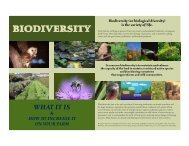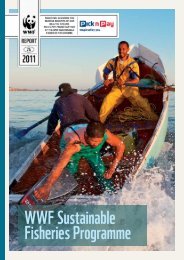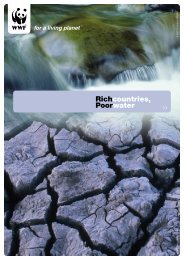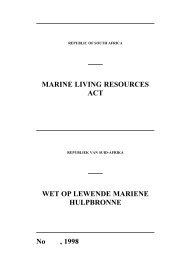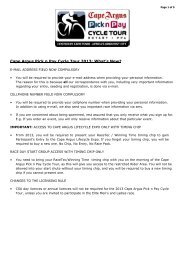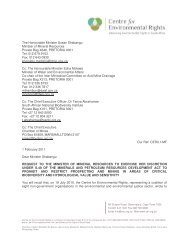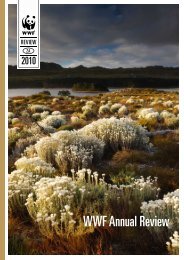State of Management of South Africaââ¬â¢s ... - WWF South Africa
State of Management of South Africaââ¬â¢s ... - WWF South Africa
State of Management of South Africaââ¬â¢s ... - WWF South Africa
- No tags were found...
You also want an ePaper? Increase the reach of your titles
YUMPU automatically turns print PDFs into web optimized ePapers that Google loves.
STATE OF MANAGEMENT OF SOUTH AFRICA’S MARINE PROTECTED AREASA People and Parks conservation <strong>of</strong>ficer was based on a full time basis at the MPA <strong>of</strong>fice.There was a planned education and awareness programme linked to the objectives andneeds <strong>of</strong> the MPA. This programme consisted <strong>of</strong>: primary school group visits with outdoor lessonsPUBLIC EDUCATION AND AWARENESS (75%)adult training on legislation and rocky shore ecology, which has been aimed atsubsistence fisherwomen, Coast Care workers, the Navy and other relevantorganisations,community outreach projectsThe community in Hout Bay had not been engaged with due to the alleged animosity showntowards SANParks staff. This had been brought on by the community’s false perception <strong>of</strong>SANParks as the ‘rule makers’. Rangers on patrol have increased awareness among touristsand resource users through communication, their presence and their enforcement actions.Brochures for the MPA were being developed, and information cards on abalone and rocklobster had been produced in English. SANParks staff handed out recreational activitybrochures produced by DEA, but they indicated that they struggled at times to get hold <strong>of</strong>these. The signboards positioned in busy areas and access points to the MPA illustratedrestricted and allowable activities in the different areas and provided brief detail andmotivation for the MPA and permit requirements, thereby aiding in raising awareness.INTERACTION WITH STAKEHOLDERS AND COMMUNITIES (47%)There was mixed support in adjacent communities regarding the MPA and the SANParksstaff. Some communities were opposed to the MPA and felt that they had a right to resourceswhere they have been denied access. As a result they were either involved in poaching orwere tolerant <strong>of</strong> it. Furthermore the benefits <strong>of</strong>fered by the MPA were not equitablydistributed. There was some support from other communities to the extent that they did nottolerate poaching and reported incidents to staff. Efforts had been made by SANParks to tryand develop the support and trust <strong>of</strong> local communities; however it was indicated that theseefforts had not reached the communities most opposed to the MPA and thus had not beeneffective.There had been some engagement between management and a few stakeholders, however,it was reported that most <strong>of</strong> these were not meaningful and effective due to the fact thatMCM held the mandate to allocate resources and restrict activities. It was reported thatlimited communication did occur between SANParks staff and stakeholders, but not througha planned or scheduled program, and that there were <strong>of</strong>ten problems in sharing informationwith stakeholders. Stakeholders had only been engaged where need or occasion had arisen.Specific efforts had been made to engage jet-ski users in the formulation <strong>of</strong> regulations forjet-ski use and to involve the recreational diving community in research to aid with monitoringefforts and mend bridges with this community who were dissatisfied with the introduction <strong>of</strong>permit requirement and a dive ban.Pg 59



